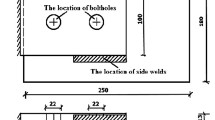Abstract
This study shows the development of the strength-design system for general bolted joints. Specifically, a simplified method of the strength design for the connectingrod bolts is proposed. The connecting-rod joint is transformed into a single-bolted-joint model by using the ring model. The axial stress on the bolt and separation behavior at the contact plane are discussed. The strength design of the connecting-rod joint can be performed by applying the unified procedure to the single-bolted-joint model. The local deformation of the connecting-rod joint and the stress on the bolt were measured and the analytical results are compared with the experimental results. Both results show fairly good agreement.
Similar content being viewed by others
References
VDI-Richtlinie 2230, “Systematisch Berechnung hochbeanspruchter Schraubenverbindungen,” VDI-Verlag GmbH, Dusseldorf (1977).
Neuendorf, K., “Ein Balkenmodell für die Berechnung des elastischen Verhaltens hochbeanspruchter Schraubenverbindungen,” Diss. TU Berlin (1975).
Bickford, J.H., “An Introduction to the Design and Behavior of Bolted Joints,”Marcel Dekker Inc., New York and Basel (1981).
Author information
Authors and Affiliations
Rights and permissions
About this article
Cite this article
Hagiwara, M. A method to simplify the strength design of bolted joints—Case of connecting-rod bolts. Experimental Mechanics 24, 28–32 (1984). https://doi.org/10.1007/BF02323202
Received:
Revised:
Issue Date:
DOI: https://doi.org/10.1007/BF02323202




